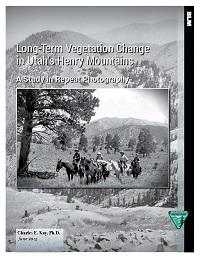Long-Term Vegetation Change in Utah’s Henry Mountains: A Study in Repeat Photography

An extensive search was conducted of archival and other sources to locate as many historical photographs as possible for the Henry Mountains in south-central Utah. Those images were then taken into the field, the original camera stations relocated, and modern pictures made of the historical scenes to evaluate long-term vegetation change and land management activities. In all, 626 repeat photo sets were compiled—608 by the author and 18 by Earl Hindley. This book includes 126 photo sets that were representative of the areas studied.
As might be expected, most photo sets contained more than one vegetation type. Grasslands were depicted in 152 photo sets, sagebrush in 99, pinyon-juniper in 293, mountain brush in 72, aspen in 37, conifers in 145, blackbrush in 71, and woody riparian species in 142. In addition, all photo sets were evaluated for plant cover and to determine whether the sites showed accelerated soil erosion.
In general, grasslands, sagebrush, and aspen have declined, while blackbrush, mountain brush, pinyon-juniper, and conifers have increased. Utah’s rangelands are generally in much better condition today than they were during the early 1900s because plant cover has increased and soil erosion has declined. Repeat photos also show that woody riparian vegetation has significantly increased regardless of whether livestock have been excluded. Contrary to popular perception, coniferous trees and forests are more abundant today than at any time in the past. In fact, the overriding problem on most Utah rangelands has been a major increase in woody plants, which in turn has dramatically reduced forage production for both livestock and wildlife. As conifers, including pinyon and juniper, have increased, so have forest fuels, thereby setting the stage for large-scale, high-intensity crown fires (a type of fire behavior that seldom, if ever, occurred in the past). As judged by stand age and forest conditions seen in early photographs, large stand-clearing fires are outside the normal range of historical variability. Historically, frequent, low-intensity surface fires, most likely set by Native Americans, kept most conifers from increasing.
